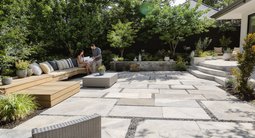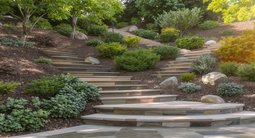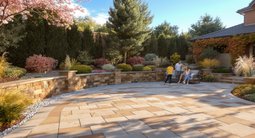TL;DR
For steep slopes (over about 25–30% grade), use framed stairs with consistent risers (6–7.5 inches) and code-ready railings; for gentler grades, timber or stone box steps with 12–18 inch treads feel natural and reduce maintenance. Prioritize drainage: 4–6 inches of compacted gravel under every step and a 1–2% surface pitch. To compare layouts, materials, and costs on your own photo, test designs in ReimagineHome.ai.
Why Outdoor Design and Curb Appeal Matter Right Now

Primary garden paths with uniform, safe stairs provide comfortable, low-maintenance outdoor movement.
Primary garden paths typically range from 36–48 inches wide for comfortable use. Outdoor stairs on a slope demand the same rigor: uniform risers, clear drainage, and stable landings make day‑to‑day movement safer and your landscaping more resilient. In most yards, framed stairs excel on steep grades while timber or stone steps shine on moderate slopes. Choose the approach that protects the hillside, controls runoff, and supports low-maintenance curb appeal.
Why Landscaping, Gardening & Hardscaping Are Changing
Hardscape elements often account for 50–70% of a low‑maintenance yard budget. Climate shifts and intense storm events are pushing designs toward robust drainage, durable materials, and fewer wood‑to‑soil contact points. Work‑from‑home life means stairs double as daily circulation, so code‑like consistency and lighting matter more. Water use restrictions push drought‑tolerant plantings that stabilize slopes without constant irrigation. The upshot: invest once in the right stair typology and base prep; it reduces erosion, weeding, and rebuilds for years.
Anecdote
On a wooded hillside lot, the owners debated wood stringers versus timber box steps. A 30% grade and heavy rains tipped the decision: framed stairs with railings, metal post bases, and open treads. After the first storm, the gravel below the flight stayed dry and stable—no washouts, no wobble—proving the right typology beats the prettiest picture.
Key Landscaping & Hardscaping Trends (and How ReimagineHome.ai Shows Them)
Experts recommend a 1–2% slope for patio and tread surfaces to shed water away from structures. Here’s how to bring modern landscaping stairs into focus—and preview them before you dig: - Layered planting and year-round structure - Stone, gravel, and stepping-stone paths - Outdoor rooms, seating pockets, fire pits - Drought-tolerant and native planting layouts - Modern curb appeal changes that boost value Framed stringer stairs: Best when the hillside is steep and direct access is essential. Use posts on concrete footings below frost depth, stringers sized for 6–7.5 inch risers, and non-slip treads. Keep wood 1 inch above grade with metal post bases to avoid rot. Timber or box steps: Ideal on gentler slopes. Create 4–6 inch rises with 12–18 inch treads. Set treated timbers, stone, or concrete modules on 4–6 inches of compacted gravel; add geotextile beneath to slow fines migration. Backfill treads with compacted gravel, decomposed granite, or pavers for longevity. Stone or precast concrete steps: The buy‑once option. Heavier up front, lighter over time. Choose bush‑hammered or broom finishes for traction; integrate cheek walls or small retaining risers to lock everything in. ReimagineHome.ai helps you preview materials, lighting, grading and terraces, landing locations, and planting massing. Upload a photo and test stringer versus box steps, switchbacks, rail placements, and night lighting to see how drainage and slope lines affect the final look.
How to Use ReimagineHome.ai to Visualize Yards, Paths & Patios
For airflow and maintenance, shrubs should be planted 18–24 inches from foundations. The same precision applies to stairs: distances, rises, and treads must be intentional. 1. Upload a clear exterior or yard photo. 2. Pick a style or function (low‑maintenance, modern, family‑friendly, woodland). 3. Test path shapes, patio sizes, step risers (4–7.5 inches), treads (12–18 inches), and switchbacks for steep grades. 4. Experiment with planting layers, lighting, rail locations, and focal points like boulders or a landing bench. 5. Generate multiple versions and compare before committing—then export your favorite for a contractor or DIY plan.
Real-World Stories — Landscaping & Hardscaping in Action
Thoughtful front yard updates can significantly increase perceived home value. The right stair approach can be the difference between a nervous climb and an inviting arrival. - A small urban yard redesigned with raised beds and stepping stones for usable space. Box steps with 5-inch risers, 14-inch treads, and crushed gravel treads linked landing to sidewalk; low-voltage riser lights solved night safety. Outcome: no water pooling, easy snow shoveling, and less weeding. - A seller improving curb appeal ahead of listing. Framed staircase replaced a muddy scramble; 6.75-inch risers and a central 4-foot landing met code-like consistency, and plantings screened utilities. Outcome: faster showings and a clean inspection thanks to real footings and railings. - A family yard transformed for play, privacy, and low upkeep. The team chose stone slab steps with a gentle 1–2% tread pitch, plus switchbacks to tame a 28% grade. Outcome: strollers and grandparents navigate comfortably; erosion vanished after the first storm. Each anecdote ends with a practical payoff: predictable rises, proper drainage, and durable treads prevent the maintenance spiral.
Visualization Scenario
Upload your slope photo to ReimagineHome.ai, draw a path line, and toggle between straight-stringer stairs and switchback box steps. Add a landing, shift riser height from 5 to 7 inches, and preview at night with step lights. The side‑by‑side renders make the maintenance and drainage implications obvious before you spend a dollar on materials.
FAQ
- How do I design a small backyard layout? Use a 36–48 inch primary path, keep stair risers 4–6 inches with 12–16 inch treads, and add a landing every 6–8 risers. Consolidate functions—grill, seating, and a compact lawn—and use switchbacks to reduce slope. - How do I create low-maintenance landscaping? Limit materials, use drought‑tolerant or native plants, and design drainage first: 4–6 inches of compacted gravel under steps and a 1–2% surface pitch. Choose stone, precast concrete, or ground‑contact rated timbers for longevity. - Can I preview landscaping ideas using a photo? Yes. Upload a picture to ReimagineHome.ai to test framed stairs vs. box steps, landing positions, railings, lighting, and plant palettes in minutes. - How far should shrubs be from my foundation? Keep 18–24 inches of clearance for airflow and maintenance, and maintain a 1–2% grade away from structures to move water. - What materials work best for modern hardscaping? Concrete, stone slabs, and gravel are top choices; aim for non‑slip finishes and consistent 6–7.5 inch risers with 12–14 inch treads for stairs. Use compacted bases and geotextile under gravel to prevent settling.
Visualize Your Home’s Next Chapter
Seat walls are most comfortable at 17–19 inches high—a reminder that human‑scaled dimensions are everything outside. Apply the same care to stairs: pick the typology that matches your slope, give every step a compacted gravel base, and keep water moving. Imagine morning coffee on the landing, evening path lights guiding guests, and a hillside that feels effortless year‑round. Before you break ground, explore every possibility. Try ReimagineHome.ai with a single photo.
.svg)

.svg)













.png)